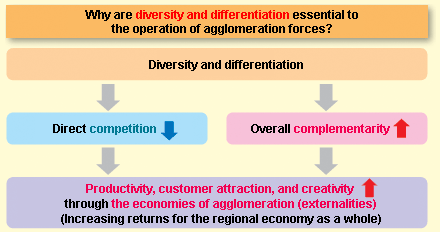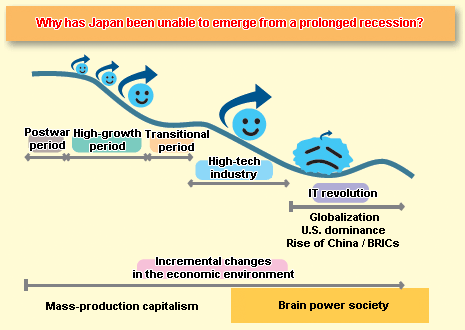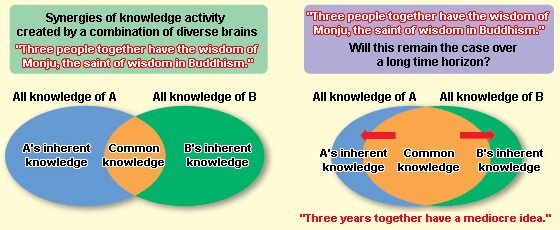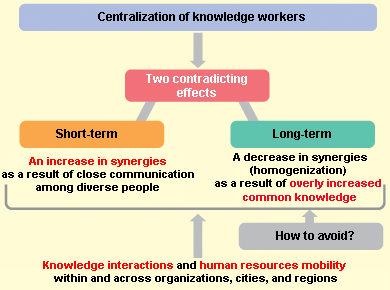Japan remains bogged down in long-term economic stagnation, which has now come to be referred to as Japan's "lost two decades." How can we revive this country and turn it into a dynamic society that can lead the world?
Why diversity matters
Spatial economics in which I specialize is a new field of economics that has developed rapidly since the 1990s. It builds on and integrates the theories of geographic space including urban economics, regional economics, and international trade theories, centering on the idea that agglomeration forces?which manifest in the form of improved productivity, customer attraction, and/or creativity?arise from the proximity of diverse human activities such as production, consumption, distribution, research, and education (see The Spatial Economy: Cities, Regions, and International Trade, co-authored by Masahisa Fujita, 2008 Nobel Prize laureate Paul Krugman, and Anthony J. Venables).
We have witnessed the remarkable development of information and communication technologies (ICTs), most notably the Internet, and the emergence of advanced transportation technologies such as container ships and jet air cargo carriers. Such technological innovations, coupled with the establishment of the World Trade Organization (WTO) and the conclusion of a range of bilateral and regional free trade agreements, has resulted in significant reductions in broadly-defined transport costs associated with the movement of goods, services, money, information, and people. When transport costs are lowered, manufacturers of goods find less need to produce near their markets and they can choose a specific location where they can take advantage of the economies of scale, hence resulting in the formation of agglomeration. Such clustering would work to increase the possibility of direct competition among companies, provided that they are homogeneous in products, services, and/or human resources. However, when companies are diverse and sufficiently differentiated from one another, clustering could lead to greater overall complementarity and, through synergies, enhance the productivity, customer attraction, and creativity of respective companies, altogether creating a dynamism for the development of the regional economy and society as a whole.

Globalization and knowledge renaissance
During the Renaissance of the 14th to 16th centuries, two tremendous changes?the "knowledge explosion" in all fields of culture and science and Europe-wide "globalization"?occurred simultaneously across European city-states, particularly those in Italy. Drastic reductions in broadly-defined transport costs associated with the movement of people, goods, money, and information were the fundamental driving factors behind those changes. For instance, the printing press technology invented by Johannes Gutenberg must have had an enormous impact on the distribution of knowledge at the time? probably far greater than the Internet does today. As long-distance trade grew dramatically, a series of city-states were established, each with its own unique and distinct characteristics, by combining their respective competitive advantage and the economies of scale. These include the Republic of Florence as a center of finance, the Republic of Venice as a maritime city-state, the Principality of Milan as an industrial city-state, and the Roman Papal States as a religious city-state. Through subsequent competition and synergies, the productivity of the economy and knowledge creation in those city-states increased explosively.
In her book Runesansu towa Nandeattaka (What was the Renaissance?), Nanami Shiono wrote: "A city-state is a 'brain power group' created through the agglomeration of those people who may not have land but brains." This definition holds true in today's world.
Since the late 20th century, transport costs have decreased dramatically thanks to innovations in the information and communication technologies and transport technologies, heralding the age of globalization or a world without national boundaries. Meanwhile, as national boundaries became less important in economic activity, a knowledge renaissance emerged, giving rise to the new idea that an individual's brain power is the most fundamental and important resource of society. And based on this new thinking, the so-called "brain power society," the systematic agglomeration and networking of knowledge are taking place. Production activities involving only established technologies are increasingly dispersed to developing countries in pursuit of lower costs. Meanwhile, knowledge-creation activities, which involve dialogue to discuss in detail about various issues, as well as broadly-defined innovation activities are likely to concentrate in developed countries and major cities in emerging economics.
Why has Japan not been able to emerge from a prolonged recession?
The postwar Japanese economy began to surge from around 1955, riding on an enormous demand boom triggered by the Korean War. The Japanese economy then encountered a difficult transitional period, overcoming the Nixon shock in the early 1970s and the two oil shocks that followed to re-emerge as a vibrant economy with robust growth led by the high-tech industry. However, with the collapse of the bubble era at the end of the 1980s, the Japanese economy slid down into a deep trough and, for years since then, has remained trapped there. And though it appeared that Japan had finally crawled out of the trough several years ago due to higher exports fueled by the global economic bubble, the recovery was short lived and the economy once again fizzled out.

Japan was the world's richest country in 1993, achieving the highest per capita income among the member countries of the Organization for Economic Cooperation and Development (OECD). But it has since slipped down in the rankings to seventh in 2002, and further down to 19th in 2008 with Japan's per capita income falling to a level slightly below one third of that of Luxemburg, which topped the list. Such a significant drop in status, which cannot be fully explained by technical factors alone, such as changes in currency values, etc., indicates that Japan's entire social system is in need of repair.
Japanese manufacturers have become what they are today by building on and improving basic knowledge and techniques learned from the United States and Europe. In years to come, however, Japan must chart its own course to become a global base for knowledge creation and innovation?one that is distinctively different from the U.S. and the European Union?and lead the world in exploring the knowledge frontier. To achieve this end, Japan's system needs an overhaul. In doing so, promoting the diversity and autonomy of just about everything?people, human resources, companies, universities, cities and regions, and so forth?is of the utmost importance.
A system for reviving Japan
In a knowledge-creation society, the brain power of individuals will be the principal resources. Here, we must remember that brain power is "software" and that we cannot expect any synergy between two identical pieces of software. Synergy from diversity is critical to creativity and the essential idea of this is well expressed in the Japanese proverb "san-nin yoreba Monju no chie," which literally translates as "three people together have the wisdom of Monju (the saint of wisdom in Buddhism).
When a group of people are engaged in certain joint-knowledge activity, they need to have a certain degree of common knowledge to facilitate communication. Meanwhile, a group of people having the same knowledge in common would have no incentive to cooperate. Accordingly, a group should be an adequately balanced mix of both common and inherent knowledge. However, close cooperation over a prolonged period of time would increase the proportion of shared knowledge and we could end up with a case of "san-nen yoreba tada no chie" (three years together have a mediocre idea).

Since the Meiji Restoration in 1868, which marked the beginning of Japan's period of modernization, up to few decades ago, synergies were created and promoted by diverse people coming together in Tokyo and the other big cities, and this drove the development of Japan as a whole. The result was the centralization of knowledge workers, as symbolized by the fact that all publishers of major newspapers are headquartered in Tokyo. This system, however, is no longer viable today, an era in which we need to explore and expand the knowledge frontier. Diversity and autonomy will become essential factors in the years to come, and it is therefore imperative to stimulate knowledge interactions and human mobility across organizations, cities, and regions of the world.

One way to achieve that end would be to reverse the Meiji Restoration. That is, whereas the Meiji government established a centralized administrative system by replacing han (feudal domains) with prefectures, present-day Japan should create a new, decentralized social system. For instance, consider reorganizing Japan as a federation of about 10 regions, each with unique regional characteristics revolving around specific industrial, knowledge, intellectual agglomeration, or a knowledge cluster. Competition and cooperation among those regions would give rise to a nationwide knowledge renaissance and, eventually, Japan might be able to earn its place as a leading knowledge center in the world. The underlying idea of regional policy is that each region?through the participation of all members?should create a unique environment and mechanism to foster exciting and sustainable innovation. This involves the exploitation to the maximum extent possible and sustainable development of regional resources on one hand, and the constant introduction of new talents and knowledge on the other. The central government, for its part, needs to assist with such regional initiatives by creating a national environment and mechanism in favor of the development of diverse regions.
Regions need to take concrete steps to expand their capacity to embrace outsiders or those often left outside the mainstream of society or knowledge-creation activities. Those include foreign nationals living and/or working in Japan, young dropouts from higher education, middle-aged and elderly people wishing to actively participate in society, and people with physical or other limitations. In addition, specifically in Japan, women are often kept outside the mainstream in many activities. I believe that incorporating all those people into the core part of society by implementing specific policy measures will lead to regional development.
Making Japan the hub of knowledge network in East Asia
While seeking to revitalize the country through local developments, Japan also needs to strengthen ties with other countries in East Asia as a vital step to restoring its economic dynamism. East Asian countries have achieved high growth by effectively utilizing their abundant, inexpensive labor force while pursuing an export-oriented strategy. It is expected that they will maintain high growth and continue to lead the sustainable growth of the world economy in the near future. For that, however, not only will they need to develop further as the world's production center, but they will also need to evolve into a matured economic society comparable to that of the U.S. or Europe as a market, as well as eventually evolving into a creativity center for the world.
By utilizing the intellectual creativity of Asians to the fullest extent, it will be possible for East Asia to develop as a creativity center for the world. But this cannot be realized without close regional cooperation in the Asia region. As such, it is indispensable that we seek to further expand and deepen regional cooperation in a variety of ways and areas, both on political and economic fronts. With a view toward forming an East Asian Community, we should go ahead and take concrete steps to enhance cooperation, starting from priority areas where compelling and urgent needs exist.
Meanwhile, in parallel with deepening the existing East Asian production network, it is necessary to build an Asia-wide network for knowledge creation and interactions, one that is closely-knit yet open to the rest of the world. Only then will we be able to explore the knowledge frontier by taking the maximum advantage of synergies from diverse groups of brain power, reflecting different historical and cultural backgrounds of countries and regions in East Asia.
If Japan is to achieve growth as a major hub (or node) in such a knowledge-creation network in East Asia, it needs to attract and absorb diverse human resources from around the world to turn the entire country into an innovation platform and enhance overall agglomeration forces. Holding the key to creating such a hub is the formulation of both expectations for the future of Japan and renewed confidence based on its past performance record. Japan needs to continue to send out, in the form of concrete policy measures, strong and convincing messages heralding its viable future as an economy driven by science and technology.


